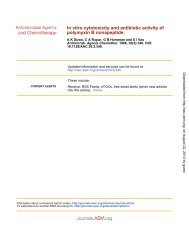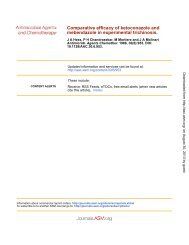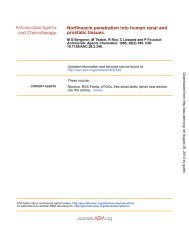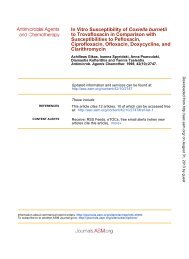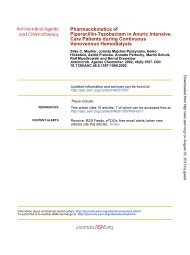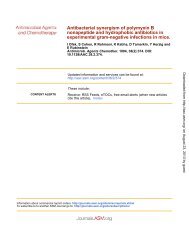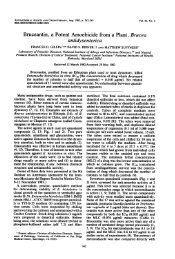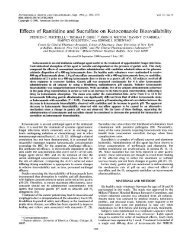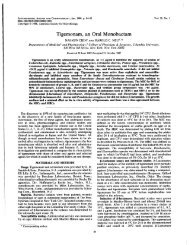Comparison of a Spectrophotometric Microdilution Method with ...
Comparison of a Spectrophotometric Microdilution Method with ...
Comparison of a Spectrophotometric Microdilution Method with ...
Create successful ePaper yourself
Turn your PDF publications into a flip-book with our unique Google optimized e-Paper software.
ANTIMICROBIAL AGENTS AND CHEMOTHERAPY, Sept. 1996, p. 1998–2003 Vol. 40, No. 9<br />
0066-4804/96/$04.000<br />
Copyright 1996, American Society for Microbiology<br />
<strong>Comparison</strong> <strong>of</strong> a <strong>Spectrophotometric</strong> <strong>Microdilution</strong> <strong>Method</strong><br />
<strong>with</strong> RPMI–2% Glucose <strong>with</strong> the National Committee for<br />
Clinical Laboratory Standards Reference Macrodilution<br />
<strong>Method</strong> M27-P for In Vitro Susceptibility Testing<br />
<strong>of</strong> Amphotericin B, Flucytosine, and Fluconazole<br />
against Candida albicans<br />
JUAN L. RODRÍGUEZ-TUDELA, 1 * JUAN BERENGUER, 2 JOAQUÍN V. MARTÍNEZ-SUÁREZ, 1<br />
AND ROSARIO SANCHEZ 2<br />
Unidad de Micología, Centro Nacional de Microbiología, Instituto de Salud Carlos III,<br />
28220 Majadahonda, 1 and Servicio de Microbiología Clinica y Enfermedades<br />
Infecciosas, Hospital General Gregorio Marañon, 2 Madrid, Spain<br />
Received 18 March 1996/Returned for modification 16 April 1996/Accepted 18 June 1996<br />
The National Committee for Clinical Laboratory Standards has proposed a reference broth macrodilution<br />
method for in vitro antifungal susceptibility testing <strong>of</strong> yeasts (the M27-P method). This method is cumbersome<br />
and time-consuming and includes MIC endpoint determination by visual and subjective inspection <strong>of</strong> growth<br />
inhibition after 48 h <strong>of</strong> incubation. An alternative microdilution procedure was compared <strong>with</strong> the M27-P<br />
method for determination <strong>of</strong> the amphotericin B, flucytosine, and fluconazole susceptibilities <strong>of</strong> 8 American<br />
Type Culture Collection strains (6 <strong>of</strong> them were quality control or reference strains) and 50 clinical isolates <strong>of</strong><br />
Candida albicans. This microdilution method uses as culture medium RPMI 1640 supplemented <strong>with</strong> 18 g <strong>of</strong><br />
glucose per liter (RPMI–2% glucose). Preparation <strong>of</strong> drugs, basal medium, and inocula was done by following<br />
the recommendations <strong>of</strong> the National Committee for Clinical Laboratory Standards. The MIC endpoint was<br />
calculated objectively from the turbidimetric data read at 24 h. Increased growth <strong>of</strong> C. albicans in RPMI–2%<br />
glucose and its spectrophotometric reading allowed for the rapid (24 h) and objective calculation <strong>of</strong> MIC<br />
endpoints compared <strong>with</strong> previous microdilution methods <strong>with</strong> standard RPMI 1640. Nevertheless, good<br />
agreement was shown between the M27-P method and this microdilution test. The MICs obtained for the<br />
quality control or reference strains by the microdilution method were in the ranges published for those strains.<br />
For clinical isolates, the percentages <strong>of</strong> agreement were 100% for amphotericin B and fluconazole and 98.1%<br />
for flucytosine. These data suggest that this microdilution method may serve as a less subjective and more<br />
rapid alternative to the M27-P method for antifungal susceptibility testing <strong>of</strong> yeasts.<br />
The frequency <strong>of</strong> serious fungal infections, especially yeast<br />
infections, is rising. This increasing incidence has been attributed<br />
to several factors, including the use <strong>of</strong> cytotoxic and immunosuppressive<br />
drugs, the prevalence <strong>of</strong> human immunodeficiency<br />
virus type 1 infection, and the widespread use <strong>of</strong> newer<br />
and more powerful antibacterial agents (2–4).<br />
Although progress in standardizing antifungal susceptibility<br />
testing has been considerable as a result <strong>of</strong> the development<br />
and publication <strong>of</strong> a reference method by the National Committee<br />
for Clinical Laboratory Standards (NCCLS), Villanova,<br />
Pa. (the M27-P method) (11), several problems remain unsolved.<br />
Most publications (5–7, 14, 15) have reported equivalence<br />
between the reference method (the M27-P method) (11) and<br />
the more user-friendly microdilution format to which it was<br />
adapted. However, this microdilution adaptation <strong>of</strong> the broth<br />
macrodilution method described in NCCLS document M27-P<br />
(11) also has drawbacks. The use <strong>of</strong> plain RPMI 1640 <strong>with</strong> a<br />
* Corresponding author. Mailing address: Unidad de Micología,<br />
Centro Nacional de Microbiología, Instituto de Salud Carlos III, Ctra.<br />
Majadahonda-Pozuelo, km. 2, 28220 Majadahonda, Madrid, Spain.<br />
Phone: 34 1 5097961. Fax: 34 1 5097966. Electronic mail address:<br />
jlrodrgz@isciii.es.<br />
1998<br />
glucose concentration <strong>of</strong> 0.2% along <strong>with</strong> the small recommended<br />
inoculum (0.5 10 3 to 2.5 10 3 CFU/ml) precludes<br />
the optimal growth <strong>of</strong> several species and/or strains <strong>of</strong> yeasts<br />
(12, 18, 19). Furthermore, the subjective visual assessment <strong>of</strong><br />
endpoints according to a 1 to4 scale is another handicap<br />
for standardization (7).<br />
In a preliminary study (18) we demonstrated that, compared<br />
<strong>with</strong> the use <strong>of</strong> standard RPMI 1640 broth alone, the use <strong>of</strong> this<br />
medium supplemented <strong>with</strong> 18 g <strong>of</strong> glucose per liter (RPMI–<br />
2% glucose) facilitated reading <strong>of</strong> growth endpoints at 24 h<br />
<strong>with</strong>out significantly affecting the MICs themselves. After comparing<br />
the RPMI–2% glucose broth microdilution method<br />
<strong>with</strong> the standard M27-P method (11), <strong>with</strong> good results (8),<br />
we proved that plain RPMI 1640 precluded the determination<br />
<strong>of</strong> the MIC 80 (lowest drug concentration giving rise to an<br />
inhibition <strong>of</strong> growth equal to or greater than 80% <strong>of</strong> that <strong>of</strong> the<br />
drug-free control) as the NCCLS recommended for endpoint<br />
estimation <strong>of</strong> azole drugs (11). The optical density <strong>of</strong> the socalled<br />
“trailing effect” produced by many Candida albicans<br />
strains was very close to the 80% inhibition optical density<br />
(OD) value, and therefore a less stringent criterion, e.g., a 50%<br />
transmission inhibitory concentration, as described by Galgiani<br />
and Stevens (9), should be used. However, the use <strong>of</strong> RPMI–<br />
2% glucose produced the same MIC, whatever method, MIC 80<br />
or 50% transmission inhibitory concentration determination,
VOL. 40, 1996 ALTERNATIVE ANTIFUNGAL SUSCEPTIBILITY TESTING METHOD 1999<br />
was used (19). Two additional studies showed good intra- and<br />
interlaboratory reproducibilities for this method (16, 21). Furthermore,<br />
a good correlation <strong>with</strong> clinical outcome could be<br />
shown for ketoconazole and fluconazole (21). Other advantages<br />
are obvious, such as an earlier and objective MIC endpoint<br />
determination (at 24 h by the spectrophotometric method<br />
versus 48 h by the visual method), simplified by the large<br />
difference between the OD <strong>of</strong> the control growth and the OD<br />
<strong>of</strong> inhibited cultures, the fact that a dose-response curve could<br />
be obtained for each pair <strong>of</strong> strain-antifungal agent tested, and<br />
a good correlation <strong>with</strong> clinical outcome (21). Furthermore, a<br />
recent report by Odds et al. (12) indicated the clear advantages<br />
for antifungal susceptibility testing when RPMI–2% glucose<br />
medium and a larger inoculum were used.<br />
We have demonstrated a good equivalence between our<br />
method and a microdilution technique <strong>with</strong> plain RPMI 1640<br />
(16, 18, 19). Nevertheless, a mandatory step for validation <strong>of</strong><br />
this spectrophotometric method <strong>with</strong> RPMI–2% glucose is its<br />
comparison <strong>with</strong> the reference method established by the<br />
NCCLS (11). In a previous study (8), we compared both methods,<br />
but only <strong>with</strong> fluconazole. The aim <strong>of</strong> the present study<br />
was to expand the previous experience <strong>with</strong> fluconazole and to<br />
test two additional antifungal drugs, amphotericin B and flucytosine,<br />
frequently used to treat human mycoses.<br />
MATERIALS AND METHODS<br />
Test organisms. Six American Type Culture Collection (ATCC) strains, C.<br />
krusei ATCC 6258, C. parapsilosis ATCC 22019, C. parapsilosis ATCC 90018, C.<br />
albicans ATCC 90028, C. albicans ATCC 24433, and C. tropicalis ATCC 750, for<br />
which reference MIC ranges for amphotericin B, flucytosine, and fluconazole are<br />
well defined (13), were tested five times on different days by the spectrophotometric<br />
method <strong>with</strong> RPMI–2% glucose. Furthermore, two additional ATCC<br />
strains, C. albicans ATCC 64550 (C. albicans AD), a well-known azole-resistant<br />
strain (22), and C. albicans ATCC 64548 (1), a susceptible strain <strong>with</strong> a minimal<br />
trailing effect, were also evaluated 20 times on different days.<br />
In addition, 50 clinical isolates <strong>of</strong> C. albicans from 50 different AIDS patients<br />
<strong>with</strong> oral candidiasis were also tested by both methods. Eighteen <strong>of</strong> these 50<br />
isolates were isolated from prospectively studied patients who either failed or<br />
responded to fluconazole therapy. They are described elsewhere (21).<br />
Each isolate was maintained in water solution at ambient temperature in the<br />
laboratory until testing was performed.<br />
Antifungal agents. The following antifungal agents (from the indicated manufacturers)<br />
were used in the study: amphotericin B (Squibb Industria Farmaceutica<br />
S.A., Madrid, Spain), flucytosine (Productos Roche, S.A., Madrid, Spain),<br />
and fluconazole (Pfizer S.A., Madrid, Spain). The drugs were provided as standard<br />
powders <strong>of</strong> known potency. Amphotericin B and fluconazole were dissolved<br />
in 100% dimethyl sulfoxide (Sigma Aldrich Quimica, S.A., Madrid, Spain).<br />
Flucytosine was dissolved in sterile distilled water. All stock solutions were<br />
frozen at 70C as100stocks until they were used.<br />
NCCLS macrodilution reference method (M27-P method). The broth macrodilution<br />
test was performed by following the guidelines <strong>of</strong> the proposed reference<br />
method for yeasts, NCCLS document M27-P (11). The medium used to<br />
prepare the 10 drug dilutions and inoculum suspension was liquid RPMI 1640<br />
<strong>with</strong> L-glutamine and 0.165 M morpholinopropanesulfonic acid (MOPS) <strong>with</strong>out<br />
sodium bicarbonate (Bio-Whittaker, Walkersville, Md.). Inocula <strong>of</strong> the yeast<br />
suspensions were prepared by the spectrophotometric procedure and ranged<br />
from 0.5 10 3 to 2.5 10 3 CFU per ml. The yeast inoculum (0.9 ml) was added<br />
to each test tube that contained 0.1 ml <strong>of</strong> a 10 concentration <strong>of</strong> one <strong>of</strong> each <strong>of</strong><br />
the antifungal agents used. The final concentrations <strong>of</strong> amphotericin B and<br />
flucytosine ranged from 16.0 to 0.03 g/ml, and that <strong>of</strong> fluconazole ranged from<br />
64.0 to 0.12 g/ml. The growth control tube(s) contained a 0.9-ml volume(s) <strong>of</strong><br />
an inoculum suspension and a 0.1-ml volume(s) <strong>of</strong> drug-free medium. In addition,<br />
1 ml <strong>of</strong> uninoculated, drug-free medium was included as a sterility control.<br />
Broth macrodilution MICs were determined after 48 h <strong>of</strong> incubation at 35C.<br />
For amphotericin B, the MIC was read as the lowest drug concentration that<br />
prevented any discernible growth. For flucytosine and fluconazole, MICs were<br />
determined by visually comparing the turbidity <strong>of</strong> each MIC tube <strong>with</strong> an 80%<br />
inhibition standard (1:5 dilution <strong>of</strong> the corresponding growth control) (11).<br />
MIC 80 endpoints by the macrodilution method were the lowest drug concentrations<br />
<strong>with</strong> a turbidity less than or equal to that <strong>of</strong> the standard. C. krusei ATCC<br />
6258, C. albicans ATCC 90028, C. albicans ATCC 64550, and C. albicans ATCC<br />
64548 were used as controls in this susceptibility test.<br />
<strong>Microdilution</strong> spectrophotometric MIC 80 method <strong>with</strong> RPMI–2% glucose.<br />
RPMI–2% glucose, an improved medium that facilitates the reading <strong>of</strong> growth<br />
inhibition by azole drugs (12, 18, 19), was used in all microdilution tests. Preparation<br />
<strong>of</strong> RPMI–2% glucose has previously been described in detail (10).<br />
A starting inoculum <strong>of</strong> 10 6 CFU/ml was prepared by the spectrophotometric<br />
method recommended by the NCCLS (11). The adjusted yeast suspensions were<br />
diluted 1:10 <strong>with</strong> RPMI–2% glucose medium, and microtiter plates were inoculated<br />
<strong>with</strong> this dilution by using an automatic pipettor programmed to dispense<br />
10 l into each well to obtain a final inoculum <strong>of</strong> approximately 10 4 CFU/ml (6).<br />
The final concentrations <strong>of</strong> amphotericin B and flucytosine ranged from 16.0 to<br />
0.03 g/ml, and those <strong>of</strong> fluconazole ranged from 64.0 to 0.12 g/ml. The<br />
inoculated plates were incubated at 35C for 24 h in a humid atmosphere. After<br />
agitation <strong>of</strong> the plates <strong>with</strong> a microtiter plate shaker for 5 min (1), spectrophotometric<br />
readings were performed <strong>with</strong> a Mios Merck automatic plate reader<br />
(Merck Igoda, S.A., Madrid, Spain) set at 630 nm for amphotericin B and at 405<br />
nm for flucytosine and fluconazole. For amphotericin B the MIC endpoint was<br />
considered the lowest drug concentration <strong>with</strong> no growth (OD 0.1). For<br />
flucytosine and fluconazole, the MIC endpoint was calculated as the lowest drug<br />
concentration giving rise to an inhibition <strong>of</strong> growth equal to or greater than 80%<br />
<strong>of</strong> that <strong>of</strong> the drug-free control (MIC 80), similar to the visual endpoint criterion<br />
recommended by the NCCLS (11). All ATCC strains described above were<br />
evaluated by this spectrophotometric method.<br />
Analysis <strong>of</strong> results. The microdilution MICs obtained by the RPMI–2% glucose<br />
microdilution method at 24 h were compared <strong>with</strong> the MICs obtained by the<br />
NCCLS reference macrodilution method at 48 h. Both on-scale and <strong>of</strong>f-scale<br />
MIC results were included in the analysis. The high <strong>of</strong>f-scale MICs (16.0 or<br />
64.0 g/ml) were converted to the next highest concentration (32.0 or 128.0<br />
g/ml, respectively), and the low <strong>of</strong>f-scale MICs (0.03 or 0.12 g/ml) were left<br />
unchanged. Discrepancies among MIC endpoints <strong>of</strong> no more than 2 dilutions<br />
(two tubes or wells) were used to calculate the percent agreement.<br />
RESULTS<br />
The MICs <strong>of</strong> the three antifungal agents obtained by the<br />
NCCLS macrodilution method for C. krusei ATCC 6258, C.<br />
albicans ATCC 90028, C. albicans ATCC 64550, and C. albicans<br />
ATCC 64548 were in the reference range (13) indicated in<br />
Table 1.<br />
Table 1 summarizes the MICs determined by the spectrophotometric<br />
method <strong>with</strong> RPMI–2% glucose for eight ATCC<br />
strains (six <strong>of</strong> them were quality control or reference isolates)<br />
(13). The equivalence between both methods was excellent<br />
when the two recommended quality control strains (13) and C.<br />
albicans ATCC 24433 were compared.<br />
As expected, some discrepancies were detected <strong>with</strong> reference<br />
strains, and they are indicated in Table 1. Three MIC<br />
determinations for amphotericin B, for C. albicans ATCC<br />
90028 and C. tropicalis ATCC 750, fell outside the range (0.25<br />
g/ml). For C. tropicalis ATCC 750 and flucytosine, all MIC<br />
determinations fell outside the reference range. For fluconazole<br />
and C. tropicalis ATCC 750, two MIC determinations<br />
(both 0.25 g/ml) were outside the range. In addition, a fluconazole<br />
MIC <strong>of</strong> 2.0 g/ml for C. parapsilosis ATCC 90018 was<br />
also outside the reference range. The remaining MICs obtained<br />
for the reference strains were in the published range<br />
(13) and are presented in Table 1.<br />
Tables 2, 3 and 4 provide the MICs <strong>of</strong> the three tested<br />
antifungal agents obtained by both methods. The comparison<br />
in each table is strain by strain. An excellent correlation was<br />
shown for amphotericin B and fluconazole because the percent<br />
agreement was 100%. For flucytosine, 98.1% agreement was<br />
obtained. For one strain (isolate 47) the flucytosine MIC was<br />
1.0 g/ml by the NCCLS method but 0.12 g/ml by the<br />
RPMI–2% glucose method (Table 3). Furthermore, when for<br />
calculation <strong>of</strong> the percent agreement a discrepancy <strong>of</strong> no more<br />
than one tw<strong>of</strong>old dilution was used, the results were as follows.<br />
For amphotericin B, the percent agreement was the lowest<br />
obtained, being 84%. For 47 (97%) isolates, the flucytosine<br />
and fluconazole MICs were the same or differed by one tw<strong>of</strong>old<br />
dilution. In addition, strains for which fluconazole MICs<br />
were higher (Table 4, isolates 37 to 50) were detected by both<br />
methods. For all <strong>of</strong> the strains the MICs were the same or<br />
differed by one tw<strong>of</strong>old dilution.
2000 RODRÍGUEZ-TUDELA ET AL. ANTIMICROB. AGENTS CHEMOTHER.<br />
TABLE 1. <strong>Comparison</strong> <strong>of</strong> broth macrodilution MICs determined by the reference method (M27-P method) and an alternative<br />
microdilution test <strong>with</strong> RPMI–2% glucose against quality control, reference, and other ATCC strains<br />
Organism f Antifungal agent<br />
C. krusei ATCC 6258 (quality<br />
control strain)<br />
C. parapsilosis ATCC 22019<br />
(quality control strain)<br />
C. albicans ATCC 24433<br />
(reference strain)<br />
C. albicans ATCC 90028<br />
(reference strain)<br />
C. tropicalis ATCC 750<br />
(reference strain)<br />
C. parapsilosis ATCC 90018<br />
(reference strain)<br />
Eighteen strains isolated from 18 AIDS patients <strong>with</strong> oropharyngeal<br />
candidiasis have been described elsewhere (21).<br />
Nine <strong>of</strong> them did not respond to fluconazole, being well-documented<br />
cases <strong>of</strong> clinical failure. For those strains the fluconazole<br />
MICs were 2.0 g/ml by the NCCLS macrodilution<br />
method and 4.0 g/ml by the spectrophotometric method<br />
<strong>with</strong> RPMI–2% glucose. For eight <strong>of</strong> the nine strains the fluconazole<br />
MICs were 8.0 g/ml by both methods. On the<br />
other hand, nine AIDS patients <strong>with</strong> oropharyngeal candidiasis<br />
were well-documented cases <strong>of</strong> clinical success <strong>with</strong> fluconazole.<br />
For the strains from those patients, fluconazole MICs<br />
were 0.5 g/ml by the NCCLS macrodilution method and<br />
0.25 g/ml by the spectrophotometric method <strong>with</strong> RPMI–<br />
2% glucose. No clinical data were available for the patients<br />
from whom the remaining isolates were obtained.<br />
DISCUSSION<br />
Despite the introduction in 1992 by NCCLS <strong>of</strong> a proposed<br />
standard method for antifungal susceptibility testing (11), several<br />
unresolved drawbacks remained. The search for alternative<br />
methods has been constant, and several investigators (5–7,<br />
14, 15) have published descriptions <strong>of</strong> microdilution methods<br />
comparable to the macrodilution technique recommended by<br />
NCCLS (11). The most popular <strong>of</strong> these microdilution methods,<br />
although in a more user-friendly format, is a reduced copy<br />
<strong>of</strong> the macrodilution format, but it had problems similar to<br />
MIC (g/ml)<br />
Reference rangea RPMI–2% glucose method<br />
Amphotericin B 0.5–2.0 0.5–1.0 b<br />
Flucytosine 4.0–16.0 4.0–8.0 b<br />
Fluconazole 16.0–64.0 32.0–64.0 b<br />
Amphotericin B 0.25–1.0 0.5–0.5 b<br />
Flucytosine 0.12–0.5 0.25–0.25 b<br />
Fluconazole 2.0–8.0 2.0–4.0 b<br />
Amphotericin B 0.25–1.0 0.25–0.5 b<br />
Flucytosine 1.0–4.0 1.0–2.0 b<br />
Fluconazole 0.25–1.0 0.5–1.0 b<br />
Amphotericin B 0.5–2.0 0.25 (3 c )–0.5 b<br />
Flucytosine 0.5–2.0 0.5–1.0 b<br />
Fluconazole 0.25–1.0 0.25–1.0 b<br />
Amphotericin B 0.5–2.0 0.25 (3)–1.0 b<br />
Flucytosine 0.12–0.25 0.5 (1)–1.0 (4) b<br />
Fluconazole 1.0–4.0 0.25 (2)–4.0 b<br />
Amphotericin B 0.5–2.0 0.5–1.0 b<br />
Flucytosine 0.12–0.25 0.06–0.25 b<br />
Fluconazole 0.25–1.0 1.0–2.0 (1) b<br />
C. albicans ATCC 64550 (22) Amphotericin B NA d<br />
0.25–1.0 e<br />
Flucytosine NA 0.5–2.0 e<br />
Fluconazole NA 16.0–128.0 e<br />
C. albicans ATCC 64548 (1) Amphotericin B NA 0.12–1.0 e<br />
Flucytosine NA 0.06–0.25 e<br />
Fluconazole NA 0.25–0.5 e<br />
a The reference range was established by the broth macrodilution method (the NCCLS M27-P method) (13).<br />
b Five determinations for the three antifungal agents on different days.<br />
c Values in parentheses are the number <strong>of</strong> MIC determinations outside the reference range.<br />
d NA, not available.<br />
e Twenty determinations for the three antifungal agents on different days.<br />
f Numbers in parentheses are reference numbers.<br />
those <strong>of</strong> the macrodilution format, such as visual endpoint<br />
determination, a small starting inoculum, and a long incubation<br />
period (48 h) (17).<br />
The use <strong>of</strong> this method (7) in our laboratory indicated that<br />
the growth <strong>of</strong> many strains was suboptimal when the OD was<br />
TABLE 2. <strong>Comparison</strong> <strong>of</strong> amphotericin B MICs obtained by<br />
NCCLS macrodilution method (M27-P method) <strong>with</strong> those<br />
obtained by microdilution <strong>with</strong> RPMI–2% glucose<br />
Isolate no.<br />
(no. <strong>of</strong> isolates)<br />
NCCLS<br />
(M27-P)<br />
MIC (g/ml)<br />
RPMI–2%<br />
glucose<br />
1 (1) 0.06 0.12<br />
2 (1) 0.06 0.25<br />
3, 4 (2) 0.12 0.12<br />
5 (1) 0.12 0.25<br />
6-8 (3) 0.12 0.5<br />
9, 10 (2) 0.25 0.12<br />
11 (1) 0.25 0.25<br />
12-18 (7) 0.25 0.5<br />
19, 20 (2) 0.5 0.12<br />
21-23 (3) 0.5 0.25<br />
24-33 (10) 0.5 0.5<br />
34, 35 (2) 0.5 1.0<br />
36, 37 (2) 1.0 0.25<br />
38-49 (12) 1.0 0.5<br />
50 (1) 1.0 1.0
VOL. 40, 1996 ALTERNATIVE ANTIFUNGAL SUSCEPTIBILITY TESTING METHOD 2001<br />
TABLE 3. <strong>Comparison</strong> <strong>of</strong> flucytosine MICs obtained by NCCLS<br />
macrodilution method (M27-P method) <strong>with</strong> those obtained<br />
by microdilution <strong>with</strong> RPMI–2% glucose<br />
Isolate no.<br />
(no. <strong>of</strong> isolates)<br />
NCCLS<br />
(M27-P)<br />
MIC (g/ml)<br />
RPMI–2%<br />
glucose<br />
1 (1) 0.06 0.12<br />
2-5 (4) 0.12 0.06<br />
6-22 (17) 0.12 0.12<br />
23 (1) 0.12 0.25<br />
24-42 (19) 0.25 0.12<br />
43, 44 (2) 0.25 0.25<br />
45 (1) 0.25 1.0<br />
46 (1) 0.5 0.25<br />
47 (1) 1.0 0.12<br />
48 (1) 1.0 0.25<br />
49 (1) 1.0 0.5<br />
50 (1) 32.0 32.0<br />
monitored by reading <strong>with</strong> a spectrophotometer (18, 19).<br />
Therefore, we developed a new microdilution method based<br />
on the standard broth macrodilution yeast susceptibility test<br />
method, but <strong>with</strong> several differences: (i) the same RPMI 1640<br />
medium recommended by the NCCLS (11) was used, but it was<br />
supplemented <strong>with</strong> 18 g <strong>of</strong> glucose per liter (RPMI–2% glucose)<br />
(18), (ii) an inoculum <strong>of</strong> 10 4 CFU/ml was used, and (iii)<br />
the microdilution plates were agitated before reading the results<br />
(1) and the MIC endpoint was estimated by spectrophotometric<br />
reading at 24 h.<br />
We compared the fluconazole MICs for C. albicans by both<br />
methods, <strong>with</strong> very good results (8). In the present study we<br />
tested eight ATCC strains five times on different days. Six <strong>of</strong><br />
them were the quality control or reference strains recommended<br />
by the NCCLS (13). The remaining two strains were<br />
C. albicans ATCC 64548, a susceptible strain (1) <strong>with</strong> a minimal<br />
trailing effect, and C. albicans 64550 (C. albicans AD), a<br />
well-known azole-resistant strain (22). When the MICs <strong>of</strong> the<br />
three antifungal agents tested for C. krusei ATCC 6258, C.<br />
parapsilosis ATCC 22019, and C. albicans ATCC 24433 obtained<br />
by both methods were compared, excellent results were<br />
obtained because all MICs fell in the reference range (Table 1)<br />
(13). However, several discrepancies were detected <strong>with</strong> C.<br />
albicans ATCC 90028, C. tropicalis ATCC 750, and C. parapsilosis<br />
ATCC 90018.<br />
Three amphotericin B MIC determinations for C. albicans<br />
ATCC 90028 were 0.25 g/ml instead <strong>of</strong> between 0.5 and 2.0<br />
g/ml, which is the reference range (Table 1) (13). Pfaller et al.<br />
(15), using a broth microdilution method, obtained similar<br />
results; their modal MIC <strong>of</strong> amphotericin B for C. albicans<br />
ATCC 90028 estimated at 24 h was 0.25 g/ml. In that study<br />
(15), the modal MIC visually determined at 48 h was 0.25<br />
g/ml, being 0.5 g/ml when the endpoint estimation was by<br />
the spectrophotometric method. Furthermore, in the study<br />
that followed determination <strong>of</strong> the reference range, Pfaller et<br />
al. (13) obtained an amphotericin B MIC <strong>of</strong> 0.25 g/ml 16<br />
times.<br />
A fluconazole MIC <strong>of</strong> 2.0 g/ml for C. parapsilosis ATCC<br />
90018 was outside the reference range (Table 1) (13). The<br />
inoculum <strong>of</strong> 10 4 CFU/ml used in the spectrophotometric<br />
method <strong>with</strong> RPMI–2% glucose compared <strong>with</strong> that used in<br />
the NCCLS broth macrodilution method (0.5 10 3 to 2.5 <br />
10 3 CFU/ml) could be an explanation for this MIC. In addition,<br />
Pfaller et al. (13) obtained a fluconazole MIC <strong>of</strong> 2.0 g/ml<br />
four times in the study establishing the reference range. This<br />
result was obtained only 1.8% <strong>of</strong> the time. However, it was the<br />
only fluconazole MIC outside the reference range for this<br />
ATCC strain (13).<br />
For C. tropicalis ATCC 750, three amphotericin B MICs <strong>of</strong><br />
0.25 g/ml were outside the reference range. Although, the<br />
reference range was established to be between 0.5 and 2.0<br />
g/ml, an amphotericin B MIC <strong>of</strong> 0.25 g/ml was obtained 13<br />
times in that study (13).<br />
All flucytosine MICs for C. tropicalis ATCC 750 were outside<br />
the reference range. The inoculum used in this spectrophotometric<br />
method (10 4 CFU/ml) could be the explanation<br />
for the MICs that were obtained. For fluconazole and C. tropicalis<br />
ATCC 750, MICs <strong>of</strong> 0.25 g/ml were obtained twice, an<br />
MIC <strong>of</strong> 1.0 g/ml was obtained once, and an MIC <strong>of</strong> 4.0 g/ml<br />
was detected once. By a microdilution method, Pfaller et al.<br />
(15) obtained fluconazole MICs <strong>of</strong> 0.5 g/ml when the reading<br />
method was visual and 0.25 g/ml when the spectrophotometer<br />
was used to read the results. At 48 h, a fluconazole MIC <strong>of</strong> 1.0<br />
g/ml was estimated by both methods. So, it seems that the<br />
MIC endpoint for fluconazole, detected by the broth microdilution<br />
method at 24 h, for C. tropicalis ATCC 750 could be<br />
lower than those obtained by the NCCLS broth macrodilution<br />
reference method.<br />
As a whole, <strong>with</strong> C. tropicalis and flucytosine as an exception,<br />
the MIC endpoints for the quality control and reference strains<br />
for amphotericin B, flucytosine, and fluconazole presented<br />
here have also been obtained by other investigators in different<br />
studies (13, 15). Therefore, our results are not unusual and<br />
could be accepted as adequate.<br />
On the other hand, 50 isolates <strong>of</strong> C. albicans from patients<br />
<strong>with</strong> oropharyngeal or esophageal candidiasis were tested by<br />
both methods. The percent agreement between both methods<br />
was excellent, being 100% for amphotericin B and fluconazole.<br />
Agreement <strong>of</strong> 98.1% was reached for flucytosine. Furthermore,<br />
when a stricter percent agreement was used (e.g., one<br />
tw<strong>of</strong>old dilution), good results were also obtained. For flucy-<br />
TABLE 4. <strong>Comparison</strong> <strong>of</strong> fluconazole MICs obtained by NCCLS<br />
macrodilution method (M27-P method) <strong>with</strong> those obtained<br />
by microdilution <strong>with</strong> RPMI–2% glucose<br />
Isolate no.<br />
(no. <strong>of</strong> isolates)<br />
NCCLS<br />
(M27-P)<br />
MIC (g/ml)<br />
RPMI–2%<br />
glucose<br />
1-6 (6) 0.12 0.12<br />
7-12 (6) 0.12 0.25<br />
13 (1) 0.12 0.5<br />
14-22 (9) 0.25 0.12<br />
23-26 (4) 0.25 0.25<br />
27 (1) 0.5 0.12<br />
28, 29 (2) 0.5 0.25<br />
30 (1) 0.5 0.5<br />
31 (1) 1.0 0.25<br />
32 (1) 1.0 1.0<br />
33, 34 (2) 2.0 4.0<br />
35 (1) 4.0 4.0<br />
36 (1) 4.0 8.0<br />
37, 38 (2) 8.0 8.0<br />
39 (1) 8.0 16.0<br />
40, 41 (2) 16.0 8.0<br />
42 (1) 16.0 32.0<br />
43 (1) 32.0 32.0<br />
44, 45 (2) 32.0 64.0<br />
46 (1) 64.0 32.0<br />
47, 48 (2) 64.0 64.0<br />
49, 50 (2) 128.0 128.0
2002 RODRÍGUEZ-TUDELA ET AL. ANTIMICROB. AGENTS CHEMOTHER.<br />
tosine and fluconazole agreement <strong>of</strong> 97% was reached. This<br />
meant that for only three isolates was there a two tw<strong>of</strong>old<br />
dilution difference between both tests. However, the percent<br />
agreement was lower for amphotericin B. For only 84% <strong>of</strong> the<br />
strains was there a one tw<strong>of</strong>old dilution difference. Nevertheless,<br />
the MIC range for amphotericin B and C. albicans was<br />
very narrow, being between 0.06 and 1.0 g/ml for all strains.<br />
As was shown in another report (21), the MIC results obtained<br />
by this spectrophotometric microdilution technique<br />
<strong>with</strong> RPMI–2% glucose correlated <strong>with</strong> the clinical outcome<br />
for AIDS patients <strong>with</strong> oropharyngeal or esophageal candidiasis<br />
treated <strong>with</strong> ketoconazole or fluconazole. Eighteen strains<br />
included in that investigation (21) were also included in the<br />
present study. The MICs obtained varied no more than one<br />
tw<strong>of</strong>old dilution compared <strong>with</strong> those obtained in the previous<br />
study (21). Also, the MICs were very similar to those obtained<br />
by the NCCLS method. At least for fluconazole, C. albicans,<br />
and oropharyngeal candidiasis, both tests identified strains for<br />
which the MICs were low and high. The interpretation <strong>of</strong> these<br />
MICs in this clinical setting indicates that strains for which<br />
fluconazole MICs (0.5 g/ml) were lower responded to fluconazole<br />
treatment, and the opposite was also true, in that<br />
isolates for which fluconazole MICs ( 8.0 g/ml) were higher<br />
did not respond. Although the number <strong>of</strong> patients is small, an<br />
in vivo correlation was achieved by both tests because similar<br />
MICs were obtained.<br />
Our previous studies (8, 10, 16, 18, 19, 21) were based mainly<br />
on the antifungal susceptibility testing <strong>of</strong> C. albicans. However,<br />
in this report and in a previous one (8), we tested quality<br />
control and reference strains <strong>of</strong> other species (C. krusei ATCC<br />
6258, C. parapsilosis ATCC 22019 and ATCC 90018, and C.<br />
tropicalis ATCC 750). The growth <strong>of</strong> these representative<br />
strains from these species is optimal in RPMI–2% glucose<br />
(20). The growth <strong>of</strong> C. glabrata and C. lusitaniae, two medically<br />
important species, is also optimal at 24 h in RPMI–2% glucose<br />
(20). However, the growth <strong>of</strong> Cryptococcus ne<strong>of</strong>ormans in either<br />
RPMI or RPMI–2% glucose is suboptimal. Therefore, the<br />
endpoint estimation should be performed at 48 to 72 h (20). In<br />
our opinion an alternative susceptibility procedure should be<br />
found for C. ne<strong>of</strong>ormans and other slowly growing species. In<br />
conclusion, the microdilution method <strong>with</strong> RPMI–2% glucose<br />
described here is easier to perform and more objective than<br />
the macrodilution reference method and the results are obtained<br />
in 24 h. Therefore, it can be recommended as a good<br />
alternative to the macrodilution reference method, the M27-P<br />
method (11).<br />
Finally, although great advances have been achieved since<br />
the introduction in 1992 <strong>of</strong> the reference standard method for<br />
antifungal susceptibility testing (11), it is still too early to assume<br />
that all the problems <strong>of</strong> standardization <strong>of</strong> tests for yeasts<br />
have been solved. Because endpoint selection remained one<br />
main problem for standardization, the use <strong>of</strong> an objective<br />
method <strong>of</strong> determination (e.g., spectrophotometric) is mandatory.<br />
This method would allow independent and objective comparisons<br />
between laboratories. Furthermore, it is necessary to<br />
perform antifungal susceptibility testing <strong>with</strong> a synthetic medium<br />
that supports good growth <strong>of</strong> yeasts (e.g., RPMI–2%<br />
glucose) and that shows large differences between the OD <strong>of</strong><br />
the control growth and the OD <strong>of</strong> inhibited cultures, helping in<br />
differentiating between susceptible and resistant strains and<br />
therefore the selection <strong>of</strong> an objective MIC endpoint. In addition,<br />
the in vitro data obtained by this method have a good<br />
correlation <strong>with</strong> clinical outcome (21). Although more studies<br />
are necessary to reaffirm this point, our present experience<br />
indicates that this assumption is feasible.<br />
ACKNOWLEDGMENTS<br />
The work at the Instituto de Salud Carlos III was supported in part<br />
by grants 96/0598 from the Fondo de Investigaciones Sanitarias and<br />
BI094-0181 from the Comision Interministerial de Ciencia y Tecnologia,<br />
both <strong>of</strong> Spain.<br />
We thank Janssen Farmaceutica, S.A.; Pfizer, S.A.; Productos<br />
Roche, S.A.; and Squibb Industria Farmaceutica, S.A., for supplying<br />
the antifungal powders.<br />
REFERENCES<br />
1. Anaissie, E., V. Paetznick, and G. P. Bodey. 1990. Fluconazole susceptibility<br />
testing <strong>of</strong> Candida albicans: microtiter method that is independent <strong>of</strong> inoculum<br />
size, temperature, and time <strong>of</strong> reading. Antimicrob. Agents Chemother.<br />
35:1641–1646.<br />
2. Anaissie, E. J., G. P. Bodey, and M. G. Rinaldi. 1989. Emerging fungal<br />
pathogens. Eur. J. Clin. Microbiol. Infect. Dis. 8:323–330.<br />
3. Banerjee, S. N., T. G. Emori, D. H. Culver, R. P. Gaynes, W. R. Jarvis, T.<br />
Horan, J. R. Edwards, J. Tolson, T. Henderson, W. J. Marone, and the<br />
National Nosocomial Infection Surveillance System. 1991. Secular trends in<br />
nosocomial primary bloodstream infections in the United States, 1980–1989.<br />
Am. J. Med. 91(Suppl. 3B):86S–89S.<br />
4. Beck-Sague, C. M., W. R. Jarvis, and the National Nosocomial Infection Surveillance<br />
System. 1993. Secular trends in the epidemiology <strong>of</strong> nosocomial fungal<br />
infections in the United States, 1980–1989. J. Infect. Dis. 167:1247–1251.<br />
5. Espinel-Ingr<strong>of</strong>f, A., T. M. Kerkering, P. R. Goldson, and S. Shadomy. 1991.<br />
<strong>Comparison</strong> study <strong>of</strong> broth macrodilution and microdilution antifungal susceptibility<br />
tests. J. Clin. Microbiol. 29:1089–1094.<br />
6. Espinel-Ingr<strong>of</strong>f, A., C. W. Kish, Jr., T. M. Kerkering, R. A. Fromtling, K.<br />
Bartizal, J. N. Galgiani, K. Villareal, M. A. Pfaller, T. Gerarden, M. G.<br />
Rinaldi, and A. Fothergill. 1992. Collaborative comparison <strong>of</strong> broth macrodilution<br />
and microdilution antifungal susceptibility tests. J. Clin. Microbiol.<br />
30:3138–3145.<br />
7. Espinel-Ingr<strong>of</strong>f, A., and M. A. Pfaller. 1995. Antifungal agents and susceptibility<br />
testing, p. 1405–1414. In P. R. Murray, E. J. Baron, M. A. Pfaller,<br />
F. C. Tenover, and R. H. Yolken (ed.), Manual <strong>of</strong> clinical microbiology, 6th<br />
ed. American Society for Microbiology, Washington, D.C.<br />
8. Espinel-Ingr<strong>of</strong>f, A., J. L. Rodriguez-Tudela, and J. V. Martinez-Suarez. 1995.<br />
<strong>Comparison</strong> <strong>of</strong> two alternative microdilution procedures <strong>with</strong> the NCCLS<br />
reference macrodilution method M27-P for in vitro testing <strong>of</strong> fluconazoleresistant<br />
and -susceptible isolates <strong>of</strong> Candida albicans. J. Clin. Microbiol. 33:<br />
3154–3158.<br />
9. Galgiani, J. N., and D. A. Stevens. 1976. Antimicrobial susceptibility testing<br />
<strong>of</strong> yeasts: a turbidimetric technique independent <strong>of</strong> inoculum size. Antimicrob.<br />
Agents Chemother. 10:721–726.<br />
10. Martinez-Suarez, J. V., and J. L. Rodriguez-Tudela. 1995. Patterns <strong>of</strong> in vitro<br />
activity <strong>of</strong> itraconazole and imidazole antifungal agents against Candida<br />
albicans <strong>with</strong> decreased susceptibility to fluconazole from Spain. Antimicrob.<br />
Agents Chemother. 39:1512–1516.<br />
11. National Committee for Clinical Laboratory Standards. 1992. Reference<br />
method for broth dilution antifungal susceptibility testing <strong>of</strong> yeasts. Proposed<br />
standard M27-P. National Committee for Clinical Laboratory Standards,<br />
Villanova, Pa.<br />
12. Odds, F. C., L. V. Vranckx, and F. Woestenborghs. 1995. Antifungal susceptibility<br />
testing <strong>of</strong> yeasts: evaluation <strong>of</strong> technical variables for test automation.<br />
Antimicrob. Agents Chemother. 39:2051–2060.<br />
13. Pfaller, M. A., M. Bale, B. Buschelman, M. Lancaster, A. Espinel-Ingr<strong>of</strong>f,<br />
J. H. Rex, M. G. Rinaldi, C. R. Cooper, and M. R. McGinnis. 1995. Quality<br />
control guidelines for National Committee for Clinical Laboratory Standards-recommended<br />
broth macrodilution testing <strong>of</strong> amphotericin B, fluconazole,<br />
and flucytosine. J. Clin. Microbiol. 33:1104–1107.<br />
14. Pfaller, M. A., C. Grant, V. Morthland, and J. Rhine-Chalberg. 1994. Comparative<br />
evaluation <strong>of</strong> alternative methods for broth dilution susceptibility<br />
testing <strong>of</strong> fluconazole against Candida albicans. J. Clin. Microbiol. 32:506–<br />
509.<br />
15. Pfaller, M. A., S. A. Messer, and S. C<strong>of</strong>fmann. 1995. <strong>Comparison</strong> <strong>of</strong> visual<br />
and spectrophotometric methods <strong>of</strong> MIC endpoint determination by using<br />
broth microdilution methods to test five antifungal agents, including the new<br />
triazole D0870. J. Clin. Microbiol. 33:1094–1097.<br />
16. Polanco, A. M., J. L. Rodriguez-Tudela, F. Baquero, A. Sanchez-Sousa, and<br />
J. V. Martinez-Suarez. 1995. Improved method <strong>of</strong> determining the susceptibility<br />
<strong>of</strong> Candida albicans to fluconazole. J. Antimicrob. Chemother. 35:<br />
155–159.<br />
17. Rex, J. H., M. A. Pfaller, M. G. Rinaldi, A. Polak, and J. N. Galgiani. 1993.<br />
Antifungal susceptibility testing. Clin. Microbiol. Rev. 6:371–381.<br />
18. Rodriguez-Tudela, J. L., and J. V. Martinez-Suarez. 1994. Improved medium<br />
for fluconazole susceptibility testing <strong>of</strong> Candida albicans. Antimicrob. Agents<br />
Chemother. 38:45–48.<br />
19. Rodriguez-Tudela, J. L., and J. V. Martinez-Suarez. 1995. Defining conditions<br />
for microbroth antifungal susceptibility tests: influence <strong>of</strong> RPMI and
VOL. 40, 1996 ALTERNATIVE ANTIFUNGAL SUSCEPTIBILITY TESTING METHOD 2003<br />
RPMI–2% glucose on the selection <strong>of</strong> endpoint criteria. J. Antimicrob.<br />
Chemother. 35:739–749.<br />
20. Rodríguez-Tudela, J. L., and J. V. Martínez-Suárez. 1995. Pruebas de<br />
sensibilidad a los antifúngicos para levaduras a partir del estandar propuesto<br />
por el NCCLS en 1992. Enferm. Infecc. Microbiol. Clin. 13:559–<br />
568.<br />
21. Rodriguez-Tudela, J. L., J. V. Martinez-Suarez, F. Dronda, F. Laguna, F.<br />
Chaves, and E. Valencia. 1995. Correlation <strong>of</strong> in-vitro susceptibility test<br />
results <strong>with</strong> clinical response: a study <strong>of</strong> azole therapy in AIDS patients. J.<br />
Antimicrob. Chemother. 35:793–804.<br />
22. Ryley, J. F., R. G. Wilson, and K. J. Barrett-Bee. 1984. Azole resistance in<br />
Candida albicans. J. Med. Vet. Mycol. 22:53–63.




